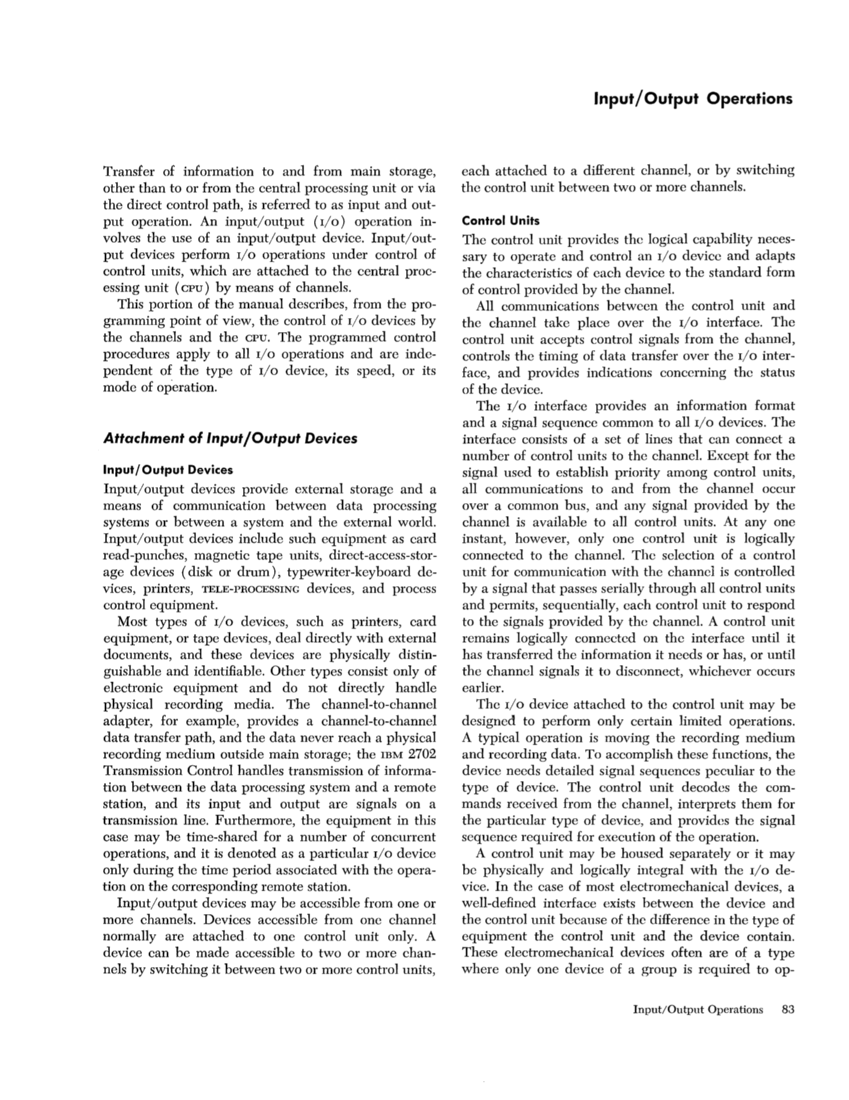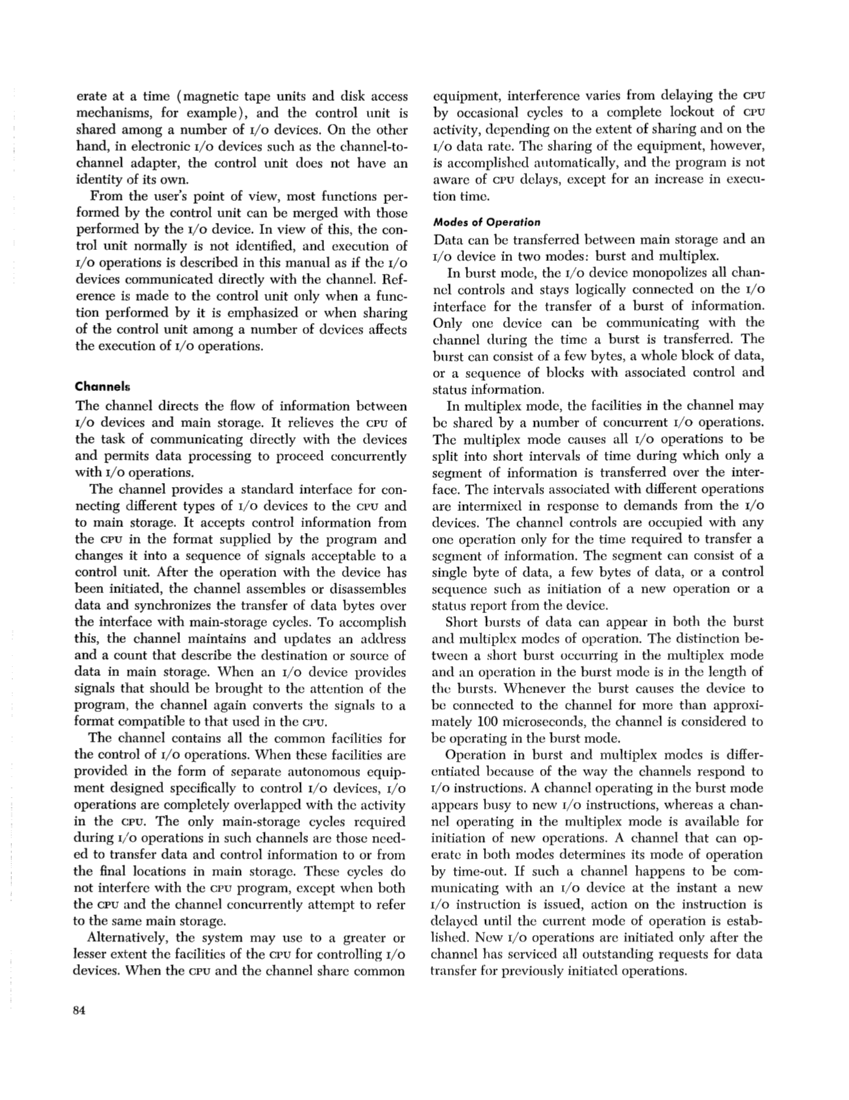Transfer of information to and from main storage,
other than to or from the central processing unit or via
the direct control path, is referred to as input and out
put operation. An inputloutput(1/0) operation in
volves the use of an inputloutput device. Input! out
put devices perform110 operations under control of
control units, which are attached to the central proc
essing unit (cpu) by means of channels.
This portion of the manual describes, from the pro
gramming point of view, the control of110 devices by
the channels and theCPU. The programmed control
procedures apply to all1/0 operations and are inde
pendent of the type of110 device, its speed, or its
mode ofop·eration. Attachment of Input/Output Devices Input / Output Devices
Input! output devices provide external storage and a
means of communication between data processing
systems or between a system and the external world.
Input! output devices include such equipment as card
read-punches, magnetic tape units, direct-access-stor
age devices (disk or drum), typewriter-keyboard de
vices, printers,TELE-PROCESSING devices, and process
control equipment.
Most types of110 devices, such as printers, card
equipment, or tape devices, deal directly with external
documents, and these devices are physically distin
guishable and identifiable.Other types consist only of
electronic equipment and do not directly handle
physical recording media. The channel-to-channel
adapter, for example, provides a channel-to-channel
data transfer path, and the data never reach a physical
recording medium outside main storage; the IBM 2702
TransmissionControl handles transmission of informa
tion between the data processing system and a remote
station, and its input and output are signals on a
transmission line. Furthermore, the equipment in this
case may be time-shared for a number of concurrent
operations, and it is denoted as a particular110 device
only during the time period associated with the opera
tion on the corresponding remote station.
Input! output devices may be accessible from one or
more channels. Devices accessible from one channel
normally are attached to one control unit only. A
device can be made accessible to two or more chan
nels by switching it between two or more control units,Input / Output Operations
each attached to a different channel, or by switching
the control unit between two or more channels.Control Units
The control unit provides the logical capability neces
sary to operate and control an110 device and adapts
the characteristics of cach device to the standard form
of control provided by the channel.
All communications betwccn the control unit and
the channel take place over the110 interface. The
control unit accepts control signals from the channel,
controls the timing of data transfer over the110 inter
face, and provides indications concerning thc status
of the device.
The110 interface provides an information format
and a signal sequence common to all1/0 devices. The
interface consists of a set of lines that can connect a
number of control units to the channel. Except for the
signal used to establish priority among control units,
all communications to and from the channel occur
over a common bus, and any signal provided by the
channel is available to all control units. At anyone
instant, however, only one control unit is logically
connected to the channel. Thc selection of a control
unit for communication with the channel is controlled
by a signal that passes serially through all control units
and permits, sequentially, each control unit to respond
to the signals provided by the channel. A control unit
remains logically connected on the interface until it
has transferred the information it needs or has, or until
the channel signals it to disconnect, whichever occurs
earlier.
The110 device attached to the control unit may be
designed to perform only certain limited operations.
A typical operation is moving the recording medium
and recording data. To accomplish these functions, the
device needs detailed signal sequences peculiar to the
type of device. The control unit decodes the com
mands received from the channel, interprets them for
the particular type of device, and provides the signal
sequence required for execution of the operation.
A control unit may be housed separately or it may
be physically and logically integral with the110 de
vice. In the case of most electromechanical devices, a
well-defined interface exists betwecn the device and
the control unit because of the difference in the type of
equipment the control unit and the device contain.
These electromechanical devices often are of a type
where only one device of a group is rcquired to op-Input/Output Operations 83
other than to or from the central processing unit or via
the direct control path, is referred to as input and out
put operation. An inputloutput
volves the use of an inputloutput device. Input! out
put devices perform
control units, which are attached to the central proc
essing unit (cpu) by means of channels.
This portion of the manual describes, from the pro
gramming point of view, the control of
the channels and the
procedures apply to all
pendent of the type of
mode of
Input! output devices provide external storage and a
means of communication between data processing
systems or between a system and the external world.
Input! output devices include such equipment as card
read-punches, magnetic tape units, direct-access-stor
age devices (disk or drum), typewriter-keyboard de
vices, printers,
control equipment.
Most types of
equipment, or tape devices, deal directly with external
documents, and these devices are physically distin
guishable and identifiable.
electronic equipment and do not directly handle
physical recording media. The channel-to-channel
adapter, for example, provides a channel-to-channel
data transfer path, and the data never reach a physical
recording medium outside main storage; the IBM 2702
Transmission
tion between the data processing system and a remote
station, and its input and output are signals on a
transmission line. Furthermore, the equipment in this
case may be time-shared for a number of concurrent
operations, and it is denoted as a particular
only during the time period associated with the opera
tion on the corresponding remote station.
Input! output devices may be accessible from one or
more channels. Devices accessible from one channel
normally are attached to one control unit only. A
device can be made accessible to two or more chan
nels by switching it between two or more control units,
each attached to a different channel, or by switching
the control unit between two or more channels.
The control unit provides the logical capability neces
sary to operate and control an
the characteristics of cach device to the standard form
of control provided by the channel.
All communications betwccn the control unit and
the channel take place over the
control unit accepts control signals from the channel,
controls the timing of data transfer over the
face, and provides indications concerning thc status
of the device.
The
and a signal sequence common to all
interface consists of a set of lines that can connect a
number of control units to the channel. Except for the
signal used to establish priority among control units,
all communications to and from the channel occur
over a common bus, and any signal provided by the
channel is available to all control units. At anyone
instant, however, only one control unit is logically
connected to the channel. Thc selection of a control
unit for communication with the channel is controlled
by a signal that passes serially through all control units
and permits, sequentially, each control unit to respond
to the signals provided by the channel. A control unit
remains logically connected on the interface until it
has transferred the information it needs or has, or until
the channel signals it to disconnect, whichever occurs
earlier.
The
designed to perform only certain limited operations.
A typical operation is moving the recording medium
and recording data. To accomplish these functions, the
device needs detailed signal sequences peculiar to the
type of device. The control unit decodes the com
mands received from the channel, interprets them for
the particular type of device, and provides the signal
sequence required for execution of the operation.
A control unit may be housed separately or it may
be physically and logically integral with the
vice. In the case of most electromechanical devices, a
well-defined interface exists betwecn the device and
the control unit because of the difference in the type of
equipment the control unit and the device contain.
These electromechanical devices often are of a type
where only one device of a group is rcquired to op-









































































































































































